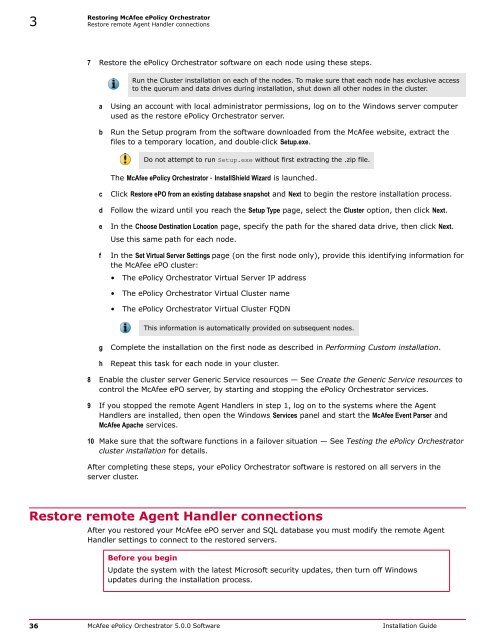ePolicy Orchestrator 5.0 Installation Guide - McAfee
ePolicy Orchestrator 5.0 Installation Guide - McAfee
ePolicy Orchestrator 5.0 Installation Guide - McAfee
You also want an ePaper? Increase the reach of your titles
YUMPU automatically turns print PDFs into web optimized ePapers that Google loves.
3<br />
Restoring <strong>McAfee</strong> <strong>ePolicy</strong> <strong>Orchestrator</strong><br />
Restore remote Agent Handler connections<br />
7 Restore the <strong>ePolicy</strong> <strong>Orchestrator</strong> software on each node using these steps.<br />
Run the Cluster installation on each of the nodes. To make sure that each node has exclusive access<br />
to the quorum and data drives during installation, shut down all other nodes in the cluster.<br />
a<br />
b<br />
Using an account with local administrator permissions, log on to the Windows server computer<br />
used as the restore <strong>ePolicy</strong> <strong>Orchestrator</strong> server.<br />
Run the Setup program from the software downloaded from the <strong>McAfee</strong> website, extract the<br />
files to a temporary location, and double‐click Setup.exe.<br />
Do not attempt to run Setup.exe without first extracting the .zip file.<br />
The <strong>McAfee</strong> <strong>ePolicy</strong> <strong>Orchestrator</strong> ‐ InstallShield Wizard is launched.<br />
c<br />
d<br />
e<br />
f<br />
Click Restore ePO from an existing database snapshot and Next to begin the restore installation process.<br />
Follow the wizard until you reach the Setup Type page, select the Cluster option, then click Next.<br />
In the Choose Destination Location page, specify the path for the shared data drive, then click Next.<br />
Use this same path for each node.<br />
In the Set Virtual Server Settings page (on the first node only), provide this identifying information for<br />
the <strong>McAfee</strong> ePO cluster:<br />
• The <strong>ePolicy</strong> <strong>Orchestrator</strong> Virtual Server IP address<br />
• The <strong>ePolicy</strong> <strong>Orchestrator</strong> Virtual Cluster name<br />
• The <strong>ePolicy</strong> <strong>Orchestrator</strong> Virtual Cluster FQDN<br />
This information is automatically provided on subsequent nodes.<br />
g<br />
h<br />
Complete the installation on the first node as described in Performing Custom installation.<br />
Repeat this task for each node in your cluster.<br />
8 Enable the cluster server Generic Service resources — See Create the Generic Service resources to<br />
control the <strong>McAfee</strong> ePO server, by starting and stopping the <strong>ePolicy</strong> <strong>Orchestrator</strong> services.<br />
9 If you stopped the remote Agent Handlers in step 1, log on to the systems where the Agent<br />
Handlers are installed, then open the Windows Services panel and start the <strong>McAfee</strong> Event Parser and<br />
<strong>McAfee</strong> Apache services.<br />
10 Make sure that the software functions in a failover situation — See Testing the <strong>ePolicy</strong> <strong>Orchestrator</strong><br />
cluster installation for details.<br />
After completing these steps, your <strong>ePolicy</strong> <strong>Orchestrator</strong> software is restored on all servers in the<br />
server cluster.<br />
Restore remote Agent Handler connections<br />
After you restored your <strong>McAfee</strong> ePO server and SQL database you must modify the remote Agent<br />
Handler settings to connect to the restored servers.<br />
Before you begin<br />
Update the system with the latest Microsoft security updates, then turn off Windows<br />
updates during the installation process.<br />
36 <strong>McAfee</strong> <strong>ePolicy</strong> <strong>Orchestrator</strong> <strong>5.0</strong>.0 Software <strong>Installation</strong> <strong>Guide</strong>
















